Latest News
March 1, 2007
By Al Dean
Fluent, now a wholly owned subsidiary of ANSYS Inc., has been in the industry for many decades with its eponymously titled and well-respected Fluent application set. Alongside its own work, Fluent has also been working with Dassault Systemes (DS), developers of the CATIA V5 platform of products. Dassault has been making a lot of integrated analysis noise of late. Its purchase of ABAQUS and the subsequent establishment of its Simulia brand shows that it means business. Alongside its own efforts, DS has also been making moves to establish links with third-party analysis and simulation developers through its Component Application Architecture V5 (CAAV5) program, with one of the major partners being Fluent. The result of this partnership is Fluent for CATIA, the first fully embedded CFD application for the CATIA user community, resulting in the company’s 20 years of CFD knowledge transferred into the CATIA V5 environment. So let’s take a look at what it does and how it interacts with CATIA.
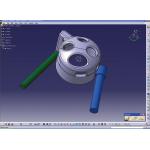 |
| Fluent for CATIA V5 |
> > This is the flow volume, either modeled from scratch or using the pre-existing tools to extract the data from the product model. The Fluent for CATIA workflow is built directly into the V5 interface, with entities within the PPR tree (to the left) and with its own workbench (to the right).
The first thing to understand is that the whole system is built into and takes place within CATIA V5 — there are no external applications. This means that it’s built to both take advantage of the existing simulation and analysis tools already within CATIA V5 and to extend their use for a CFD workflow. As such, if you’re familiar with CATIA V5, then the starting point for any review, the interface, will be immediately familiar. The Fluent for CATIA tools are found within the analysis and simulation application group.
The starting point is always going to your part or assembly within CATIA and can take the form of the part itself or the flow volume. If the part has been created in CATIA, you can use the built-in tools to both clean up the geometry (for simplification purposes) and to quickly create the internal flow volume on which the analysis is based.
Study SetUp
Once the geometry is ready, you then define the environment for the fluid flow study, done either through the workbench icons or, perhaps more commonly, through interaction with both the geometry and the PPR (Product Process Resource) tree; for those unfamiliar with CATIA parlance, PPR tree is the assembly tree. You define factors such as any symmetry within the model, whether you’re working with the solid part geometry or the fluid volume region. You define boundary conditions, such as inlets and outlets (with velocities and such), walls as well as any temperature factors if you’re conducting thermal studies.
Then, you mesh the model. The meshing controls are initially operated via a slider bar. The options vary between Quick and Rough answers and Slow and High accuracy. This varies both the meshing (quicker solve means lower quality and less accurate mesh) and convergence controls.
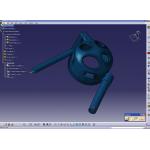 |
| Fluent for CATIA V5 |
< < The meshed flow volume, created using a mix of existing V5 and Fluent enhanced tools.
Here, Fluent has taken the existing CATIA structural analysis tools and enhanced them with its own technology. An excellent example is the mesh that CATIA produces. For quick simulation runs, the CATIA-generated tetrahedral mesh will suffice; if you’re looking to gain accurate CFD results, a basic tetrahedral mesh won’t cut the mustard, particularly at the outer boundaries and walls. A quality CFD mesh uses several layers of extruded elements to form the boundary layer, from which the rest of the mesh is built (this method kicks in once if the quality slider is at more than 75%). Another Fluent meshing enhancement is handling small gaps that the standard CATIA mesh might ignore. Here, CFD tools ensure that small gaps are meshed with a sufficient number of cells. Once your mesh is in place, the next step is to define the physics for the study.
You start by defining the study type and the expected conditions. The system currently supports both laminar and turbulent flow (including strong swirl in the latter) as well as compressible and incompressible fluids, heat transfer (conduction and convection) and the modeling of rotating equipment. Next, you define materials. As you might expect, a range of predefined fluids is supplied and this is directly integrated into the CATIA materials definition dialogs, so you use the same method of applying materials with which you’re familiar. It provides base customizable definitions for all the major fluids and gases and it’s important to note that the system also supports porous media for defining filters and other such components within your studies.
Solving and Postprocessing
Once your study is ready, you need to solve it. Fluent for CATIA is built on the Fluent 6 solver, and you have a lot of control over the calculation process, including batch processing and control over convergence, residuals, and more.
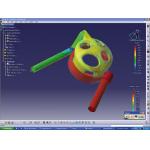 |
| Fluent for CATIA V5 |
> > You can see Inlets, Outlets, Flow, and Mesh elements in the PPR Tree as well as results data in the Fluent case. Inlets and Outlets are defined directly on the model (the red and green arrows respectively).
Again, Fluent is expanding the existing CATIA postprocessing tools and adapting them to suit fluid flow. CATIA already has a range of structural analysis postprocessing and result visualization tools for displaying fringe and shaded plots of stress, but it doesn’t have CFD-specific tools for displaying and inspecting flow vectors. Fluent has added this functionality while ensuring that its tools work in a manner familiar to CATIA users. The result is a set of postprocessing tools that allows you to visualize your results as velocity vectors, pathlines, etc. All of the results are stored alongside the geometry related files within the .CatAnalysis file that contains all of the analysis results and makes it much easier to manage the data using the data management system.
A Remarkable Piece of Work
So, we’ve got an idea of how you set up, solve, and postprocess a job, but in today’s hyperconnected world of PLM (product lifecycle management), that’s not enough — and the real benefit of CATIA and its partner application is the ability to establish associative links, interactions, and intelligence between all entities, parameters, and variables. In the case of Fluent for CATIA, this means that the base-level parametric and associative capabilities are now available to Fluent users.
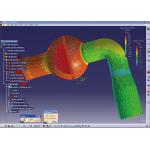 |
| Fluent for CATIA V5 |
< < Cut plane used to view the internal flow pressure and velocity within the valve flow volume.
So, as you’re defining the study, you’re essentially setting up design intent and associative links. For example, as you add inlets and outlets, these aren’t added to specific nodes as you would in Fluent’s more traditional tools, but to faces within the geometry definition. The benefit is that if you make changes to the underlying geometry, the CFD-related definition should also update so design variants and iterations can be turned around very quickly.
Taking this further, as you’re within CATIA, you’re also able to use the V5 Knowledgeware tools within the CATIA environment to create optimization routines. You will also be able to use CFD analysis as the basis for automated design checks (using sensors) within intelligent part or assembly templates, and you will be able to leverage all the other very clever things that CATIA is very good at doing. Outside of CATIA, you also have the benefit of all the links that Fluent has built up with both its own tools (such as Fluent, Tgrid, and such) as well as other simulation and analysis tools, such as ABAQUS. You can exchange data at most stages of the process, ranging from Part/Assembly geometry, surface meshes, CFD mesh, or solution data.
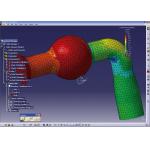 |
| Fluent for CATIA V5 |
> > Total pressure shaded and superimposed on the mesh.
In terms of CATIA V5 module prerequisites, you will need the MD2 configuration (Mechanical Design 2) and GPS (analysis). FMS (FEM surface 2) and FMD (FEM Solids 2) are not essential but are recommended for higher fidelity CFD simulations. If you want to use the Knowledgeware tools, then you’re also going to need the appropriate licenses for that too.
Fluent for CATIA V5 2.0 is a remarkable piece of work and follows Dassault’s fully integrated V5 platform concept perfectly. It takes the preexisting technology within CATIA and brings to bear Fluent’s knowledge and expertise in a specific domain. This means that the tools available are functional and can provide immediate benefit to V5 users looking to use fluid and thermal simulation as a core, integrated, part of their product development process.
Al Dean is Technology Editor of the UK’s leading product development and manufacturing journal, MCAD and is Editor of Prototype, for the rapid prototyping and direct manufacturing industry, both available by clicking here. Send your comments about this article through e-mail by clicking here. Please reference “Fluent for CATIA” in your message.
Fluent for CATIA V5 2.0
Fluent, Inc.
Lebanon, NH
CATIA V5
Dassault Systemes
Paris, France
ABAQUS, Inc.
Providence, RI
ANSYS Inc.
Canonsburg, PA
Subscribe to our FREE magazine, FREE email newsletters or both!
Latest News
About the Author
DE’s editors contribute news and new product announcements to Digital Engineering.
Press releases may be sent to them via [email protected].






